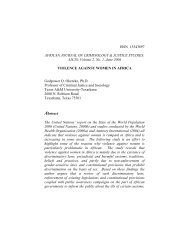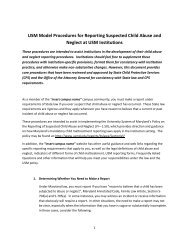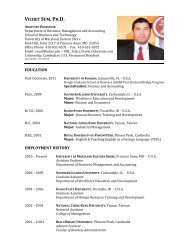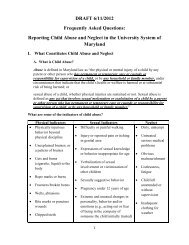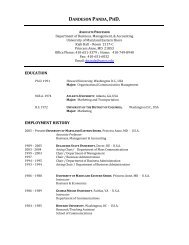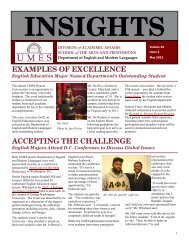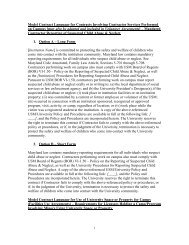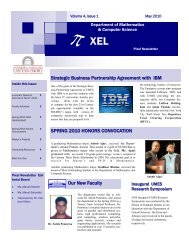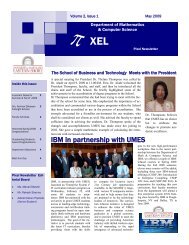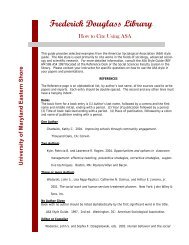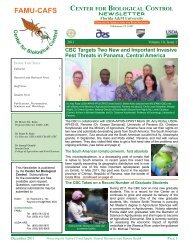Download - University of Maryland Eastern Shore
Download - University of Maryland Eastern Shore
Download - University of Maryland Eastern Shore
You also want an ePaper? Increase the reach of your titles
YUMPU automatically turns print PDFs into web optimized ePapers that Google loves.
interpersonal communication, verbal and nonverbal communication strategies, effective interviewing<br />
techniques, and patient counseling.<br />
PHAR 543 - PUBLIC HEALTH FOR PHARMACISTS<br />
This course (held throughout the 2nd term <strong>of</strong> the SP-1 year) will prepare students to identify public<br />
health issues and to identify populations at risk for a variety <strong>of</strong> diseases. Principles <strong>of</strong> epidemiology as a<br />
diagnostic discipline <strong>of</strong> population health will be explored. In addition, this course will enable the<br />
student to critically evaluate current trends in the care <strong>of</strong> patient populations. Issues relating to disaster<br />
planning and emergency preparedness will be discussed. Focus will be placed on the role <strong>of</strong> the<br />
pharmacist in the public health policy.<br />
PHAR 544 - DIRECT PATIENT CARE IN PHARMACY PRACTICE<br />
This longitudinal course is designed to develop life-long essential skills students will utilize in patientcentered<br />
care. It will cover topics such as self-care & OTC products consultation, complementary and<br />
alternative medicine consultation, point <strong>of</strong> care devices, immunizations certification and smoking<br />
cessation education.<br />
PHAR 550 - PHARMACEUTICAL CALCULATIONS<br />
This course (held throughout the 1st term <strong>of</strong> the SP-1 year) covers all aspects <strong>of</strong> pharmaceutical<br />
calculations including: fundamentals <strong>of</strong> measurement and calculation, measurement systems, dosage<br />
and concentration units, isotonic solutions, electrolyte solutions, and calculations related to<br />
compounding.<br />
PHAR 571 - INTRODUCTORY PHARMACY PRACTICE EXPERIENCE I<br />
The overarching objective <strong>of</strong> an IPPE is to emphasize the relevance <strong>of</strong> the didactic curriculum in<br />
relationship to contemporary pharmacy practice. The students will spend an eight-hour day in a<br />
pharmacy setting every other week. Students will complete instructor designed activities/assignments,<br />
Classroom Connections (CC), in experiential settings based on what is being taught in the classroom.<br />
Students will also complete Experiential Learning Objectives (ELO) while at the site. These opportunities<br />
allow students to observe first-hand the drugs, patients and disease states discussed in class, thus<br />
reinforcing didactic learning experience. Student competencies will progress as the student develops<br />
through the didactic curriculum. Students will be in a community or institutional setting.<br />
During the alternating week, students will discuss activities involving the previous week's assignments<br />
which will allow the use <strong>of</strong> small group interactions to strengthen the learning experience. In addition,<br />
students will learn basic characteristics <strong>of</strong> the top 200 drugs through self-study.<br />
PHAR 572 - INTRODUCTORY PHARMACY PRACTICE EXPERIENCE II<br />
The overarching objective <strong>of</strong> an IPPE is to emphasize the relevance <strong>of</strong> the didactic curriculum in<br />
relationship to contemporary pharmacy practice. The students will spend an eight-hour day in a<br />
pharmacy setting every other week. Students will complete instructor designed activities/assignments,<br />
Classroom Connections (CC), in experiential settings based on what is being taught in the classroom.<br />
Students will also complete Experiential Learning Objectives (ELO) while at the site. These opportunities<br />
allow students to observe first-hand the drugs, patients and disease states discussed in class, thus<br />
reinforcing didactic learning experience. Student competencies will progress as the student develops<br />
through the didactic curriculum. Students will be in a community or institutional setting; students who<br />
were in a community setting for PHAR 571 will be placed in an institutional setting for PHAR 572 and<br />
students who were in a institutional setting for PHAR 571 will be placed in an community setting for<br />
PHAR 572.<br />
92




